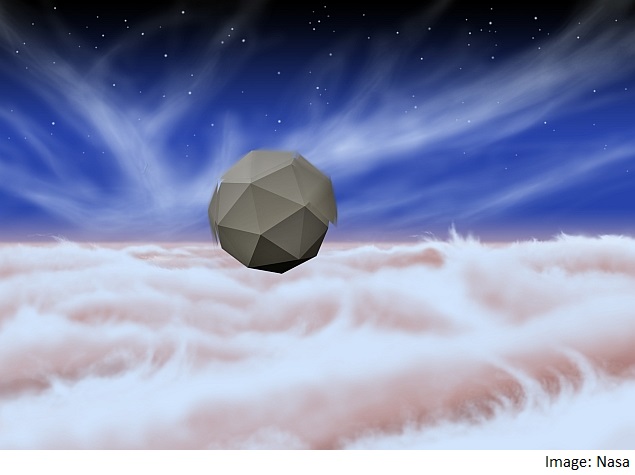- Home
- Science
- Science News
- Nasa Looking to 'Windbots' to Explore Jupiter, Saturn
Nasa Looking to 'Windbots' to Explore Jupiter, Saturn

Nasa is investigating the feasibility of creating a windbot, a robotic probe designed to stay aloft in a planet's atmosphere for a long time, to explore gas giants like Jupiter and Saturn.
Engineers at Nasa's Jet Propulsion Laboratory in Pasadena, California, are looking into the possibility of creating a windbot, a new class of robotic probe that can stay aloft in a planet's atmosphere for a long time without wings or hot-air balloons.
The one-year, $100,000 (roughly Rs. 64 lakhs) study, funded by Nasa's Innovative Advanced Concepts (NIAC) programme, will systematically investigate how future spacecraft of this kind could stay airborne and harvest energy.
Though no mission is currently scheduled to utilise windbots, the researchers hope their study will open new avenues for atmospheric science on gas giant planets using high-mobility robotic explorers.
Unlike the Moon and Mars, which have already been explored by robotic rovers, gas giant planets like Jupiter and Saturn have no solid surface on which a probe to land on.
In 1995, Nasa's Galileo spacecraft dropped off an atmospheric probe that descended into Jupiter under a parachute. The battery-powered probe survived only about an hour before succumbing to high heat and pressure as it fell into the planet's deep atmosphere.
In contrast to the plummeting probe, a windbot could have rotors on several sides of its body that could spin independently to change direction or create lift.
Adrian Stoica, principal investigator for the windbots study at JPL, points to a great example to think about from nature: a dandelion seed.
"A dandelion seed is great at staying airborne. It rotates as it falls, creating lift, which allows it to stay afloat for long time, carried by the wind. We'll be exploring this effect on windbot designs," Stoica said.
Stoica and colleagues think that, to stay airborne for a long time, a windbot would need to be able to use energy available in the planet's atmosphere. That energy might not be solar, because the probe could find itself on the planet's night side for an extended period.
Nuclear power sources also could be a liability for a floating probe because of their weight. But winds, temperature variations, and even a planet's magnetic field could potentially be sources of energy an atmospheric probe could exploit.
The team suspects the best bet for an atmospheric robot to harvest energy is turbulence - wind that's frequently changing direction and intensity. The key is variability. High wind velocity is not enough. But in a dynamic, turbulent environment there are gradients - differences in energy from high to low - that can be used.
The JPL team is characterising winds among the clouds of Jupiter to understand what kinds of places might be best for sending a windbot and to determine some of the technical requirements for its design.
Catch the latest from the Consumer Electronics Show on Gadgets 360, at our CES 2026 hub.
Related Stories
- Samsung Galaxy Unpacked 2025
- ChatGPT
- Redmi Note 14 Pro+
- iPhone 16
- Apple Vision Pro
- Oneplus 12
- OnePlus Nord CE 3 Lite 5G
- iPhone 13
- Xiaomi 14 Pro
- Oppo Find N3
- Tecno Spark Go (2023)
- Realme V30
- Best Phones Under 25000
- Samsung Galaxy S24 Series
- Cryptocurrency
- iQoo 12
- Samsung Galaxy S24 Ultra
- Giottus
- Samsung Galaxy Z Flip 5
- Apple 'Scary Fast'
- Housefull 5
- GoPro Hero 12 Black Review
- Invincible Season 2
- JioGlass
- HD Ready TV
- Laptop Under 50000
- Smartwatch Under 10000
- Latest Mobile Phones
- Compare Phones
- OnePlus Turbo 6V
- OnePlus Turbo 6
- Itel Zeno 20 Max
- OPPO Reno 15 Pro Mini 5G
- Poco M8 Pro 5G
- Motorola Signature
- Vivo Y50e 5G
- Vivo Y50s 5G
- Lenovo Yoga Slim 7x (2025)
- Lenovo Yoga Slim 7a
- Realme Pad 3
- OPPO Pad Air 5
- Xiaomi Watch 5
- Huawei Watch 10th Anniversary Edition
- Acerpure Nitro Z Series 100-inch QLED TV
- Samsung 43 Inch LED Ultra HD (4K) Smart TV (UA43UE81AFULXL)
- Asus ROG Ally
- Nintendo Switch Lite
- Haier 1.6 Ton 5 Star Inverter Split AC (HSU19G-MZAID5BN-INV)
- Haier 1.6 Ton 5 Star Inverter Split AC (HSU19G-MZAIM5BN-INV)

















